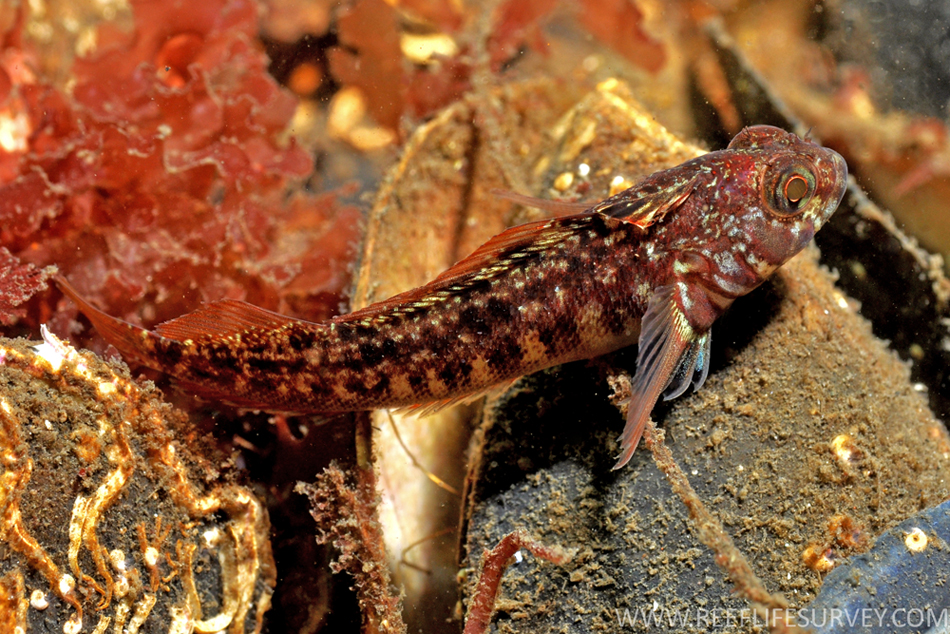Estuarine Threefin, Forsterygion gymnota Scott 1977
Other Names: Bare-backed Threefin, Estuarine Triplefin, Robust Triplefin, Tasmanian Robust Triplefin

An Estuarine Threefin, Grahamina gymnota, in the Derwent River at Battery Point, Hobart. Source: Rick Stuart-Smith / Reef Life Survey. License: CC BY Attribution
Cite this page as:
Bray, D.J. 2024, Forsterygion gymnota in Fishes of Australia, accessed 28 Jun 2025, https://fishesofaustralia.net.au/home/species/23
Estuarine Threefin, Forsterygion gymnota Scott 1977
More Info
|
Distribution |
Introduced to southeastern Tasmania, including the Derwent Estuary. The species is native to New Zealand. Inhabits shallow rocky areas in large estuaries and bays, often around wharves and piers in the Derwent Estuary near Hobart. |
|
Features |
Dorsal fin VI-VIII + XVIII-XXIV + x-xv, 1; Anal fin I-II, xxii-xxvi, 1 (total 25-29); Pectoral fin Pi ii-iii, 6-8, viii (total 17-18); Pelvic fin I, ii; Caudal fin (iv), ii, 9, ii, (iv). Scale rows 44-50 + 2; Transverse scale rows 7 + 3 + 10; Lateral line scales 20-26 + 10-18. Mandibular pore formula 5 + 1 +5. |
|
Colour |
In preservative: Head and body dark brown, sides of body with vertical dark brown streaks, belly lighter. Eye dark grey. First dorsal fin black or dark with a black blotch on posterior membranes, second and third dorsal fins dark brown. Anal fin blackish, first dorsal fin usually plain blackish. |
|
Remarks |
Although described from Tasmania, genetic studies indicate that the species is a New Zealand native, and was introduced to Tasmania - presumably via ballast water discharged by ships into the Derwent Estuary and surrounds. |
|
Etymology |
The specific name gymnotum is from the Greek gymnos (= naked) and notos (= back, in reference to the "naked, non-scaled area on the back on either side of the base of the first dorsal fin and the early part of the second dorsal". |
|
Species Citation |
Forsterygion gymnotum Scott 1977, Papers and Proceedings of the Royal Society of Tasmania 111: 158, fig. 3 Type locality: Montague Bay, southeastern Tasmania. |
|
Author |
Bray, D.J. 2024 |
|
Resources |
Estuarine Threefin, Forsterygion gymnota Scott 1977
References
Clements, K.D. 2014. Forsterygion gymnota. The IUCN Red List of Threatened Species 2014: e.T179022A1560367. https://dx.doi.org/10.2305/IUCN.UK.2014-3.RLTS.T179022A1560367.en. Accessed on 14 August 2024.
Clements, K.D., Jawad, L.A. & Stewart, A.L. 2000. The New Zealand triplefin Grahamina signata (Teleostei; Tripterygiidae): a junior synonym of G. gymnota from Tasmania. Journal of the Royal Society of New Zealand 30(4): 373-384 fig. 1 https://doi.org/10.1080/03014223.2000.9517629 (as Grahamina gymnota)
Edgar, G.J., Last, P.R. & Wells, M.W. 1982. Coastal Fishes of Tasmania and Bass Strait. Hobart : Cat & Fiddle Press 175 pp.
Feary, D.A., Wellenreuther, M. & Clements, K.D. 2009. Trophic ecology of New Zealand triplefin fishes (Family Tripterygiidae). Marine Biology 156: 1703-1714. https://doi.org/10.1007/s00227-009-1205-2
Francis, M. 2001. Coastal Fishes of New Zealand. Auckland : Reed Publishing (NZ) 3rd edn, 103 pp.
Fricke, R. 1994. Tripterygiid fishes of Australia, New Zealand and the Southwest Pacific Ocean, with descriptions of 2 new genera and 16 species (Teleostei). Theses Zoologicae 24: 1-585 figs 1-130 (as Grahamina gymnota and G. signata)
Fricke, R. & Roberts, C.D. 1993. Grahamina, a new genus for robust-bodied triplefins (Teleostei : Tripterygiidae) from New Zealand and Australia, with description of a new species. Stuttgarter Beiträge zur Naturkunde. Serie A (Biologie) 504: 1-21 figs 1-9 (described as Grahamina signata, type locality - Tauranga Bay, on south side, South Island, New Zealand, 41°47'S, 171°27'E) See ref at BHL
Furlani, D. 1996. A guide to the introduced marine species in Australian waters. Technical Report No.5. Centre for Research on Introduced Marine Pests(CRIMP), CSIRO, Hobart, Tasmania, Australia
Hardy, G.S. 1989. The genus Forsterygion Whitley & Phillipps, 1939 (Pisces: Tripterygiidae) in New Zealand and Australia, with descriptions of two new species. Journal of Natural History 23(3): 491-512
Hickey, A.J.R., Lavery, S.D., Eyton, S.R. & Clements, K.D. 2004. Verifying invasive marine fish species using molecular techniques: A model example using triplefin fishes (Family Tripterygiidae). New Zealand Journal of Marine and Freshwater Research 38: 439-446. https://doi.org/10.1080/00288330.2004.9517251 (as Grahamina gymnota)
Hickey, A.J.R., Lavery, S.D., Hannan, D.A., Baker, C.S. & Clements, K.D. 2009. New Zealand triplefin fishes (family Tripterygiidae): contrasting population structure and mtDNA diversity within a marine species flock. Molecular Ecology 18: 680-696. https://doi.org/10.1111/j.1365-294X.2008.04052.x
Jawad, L.A. 2008. Second revision of the New Zealand triplefin genus Forsterygion Whitley and Phillips, 1939 (Pisces: Tripterygiidae). Journal of Natural History 42(47-48): 2943-2989 https://doi.org/10.1080/00222930802256842
Last, P.R., Scott, E.O.G. & Talbot, F.H. 1983. Fishes of Tasmania. Hobart : Tasmanian Fisheries Development Authority 563 pp. figs.
Scott, E.O.G. 1977. Observations on some Tasmanian fishes. Part 23. Papers and Proceedings of the Royal Society of Tasmania 111: 111-180 figs 1-3 https://doi.org/10.26749/rstpp.111.111
Stewart, A.L.& Clements, K.D. 2015. 215 Family Tripterygiidae, pp. 1491-1523 in Roberts, C.D., Stewart, A.L. & Struthers, C.D. (eds). The Fishes of New Zealand. Wellington : Te Papa Press Vol. 4 pp. 1153-1748.

